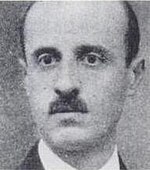Gonzalo Rodríguez Lafora
Gonzalo Rodríguez Lafora | |
|---|---|
 Gonzalo Rodríguez Lafora | |
| Born | 25 July 1886 |
| Died | 27 December 1971 (aged 85) Madrid |
| Nationality | Spanish |
| Known for | Lafora disease |
| Scientific career | |
| Fields | neurology |
Gonzalo Rodríguez Lafora (25 July 1886 – 27 December 1971) was a Spanish neurologist and psychiatrist.[1] He was a disciple of Nicolás Achúcarro and Santiago Ramón y Cajal and one of the most brilliant examples of the Spanish Neurological School (or Cajal School). He was best known now for describing (in 1911) the intracytoplasmic inclusion bodies in "Lafora disease". In total, he published approximately 200 papers covering a wide range of subjects in neurology, psychiatry, and neuropathology. He made seminal contributions not only to the clinical and scientific literature but also to the training of many noted disciples who paid him due homage as a true "maestro." Throughout his intellectual endeavors, Lafora manifested a singular purpose and intensity and a burning devotion to scientific honesty.[2][3]
In 1910, Fritz Heinrich Lewy discovered what became known as Lewy bodies,[4] and compared them to earlier findings by Lafora.[5] In 1913, Lafora described another case, and acknowledged Lewy as the discoverer, naming them cuerpos intracelulares de Lewy (Lewy bodies).[5] Konstantin Nikolaevich Trétiakoff found them in 1919 in the substantia nigra of PD brains, called them corps de Lewy and is credited with the eponym.[5] Eliasz Engelhardt argued in 2017 that Lafora should be credited with the eponym, because he named them six years before Trétiakoff.[6]
See also
References
- ^ Faraone, Stephen V.; Banaschewski, Tobias; Coghill, David; Zheng, Yi; Biederman, Joseph; Bellgrove, Mark A.; Newcorn, Jeffrey H.; Gignac, Martin; Al Saud, Nouf M.; Manor, Iris; Rohde, Luis Augusto; Yang, Li; Cortese, Samuele; Almagor, Doron; Stein, Mark A. (September 2021). "The World Federation of ADHD International Consensus Statement: 208 Evidence-based conclusions about the disorder". Neuroscience and Biobehavioral Reviews. 128: 789–818. doi:10.1016/j.neubiorev.2021.01.022. ISSN 1873-7528. PMC 8328933. PMID 33549739.
- ^ Nanduri, Anish S; Kaushal Neal; Clusmann Hans; Binder Devin K (June 2008). "The maestro don Gonzalo Rodríguez-Lafora". Epilepsia. 49 (6): 943–7. doi:10.1111/j.1528-1167.2008.01543.x. PMID 18266749. S2CID 1004316.
- ^ Fuentes-Delgado, M (December 1972). "In memory of Gonzalo Rodríguez Lafora, 1887-1971". Gaceta Médica de México. 104 (6): 509–12. PMID 4571503.
- ^ Hake MD, Ann Marie. "Dementia with Lewy bodies". MEDMERITS TM. Archived from the original on 2016-07-04.
- ^ a b c Engelhardt E (October 2017). "Lafora and Trétiakoff: the naming of the inclusion bodies discovered by Lewy". Arq Neuropsiquiatr (Historical article). 75 (10): 751–753. doi:10.1590/0004-282X20170116. PMID 29166468.
- ^ Engelhardt E, Gomes M (2017). "Lewy and his inclusion bodies: Discovery and rejection". Dement Neuropsychol. 11 (2): 198–201. doi:10.1590/1980-57642016dn11-020012. PMC 5710688. PMID 29213511.
Lafora GR, Glueck B. (1911) Beitrag zur Histopathologie der myoklonischen Epilepsie. Zeitschrift für die gesamte Neurologie und Psychiatrie 6: 1– 14.
- Articles with short description
- Short description is different from Wikidata
- Articles with hCards
- Articles with FAST identifiers
- Articles with ISNI identifiers
- Articles with VIAF identifiers
- Articles with BNE identifiers
- Articles with BNF identifiers
- Articles with BNFdata identifiers
- Articles with CANTICN identifiers
- Articles with GND identifiers
- Articles with LCCN identifiers
- Articles with NKC identifiers
- Articles with NTA identifiers
- Articles with PortugalA identifiers
- Articles with VcBA identifiers
- Articles with SUDOC identifiers
- 1886 births
- 1971 deaths
- Spanish neurologists
- Lewy body dementia
- All stub articles
- Spanish scientist stubs
- Psychiatrist stubs